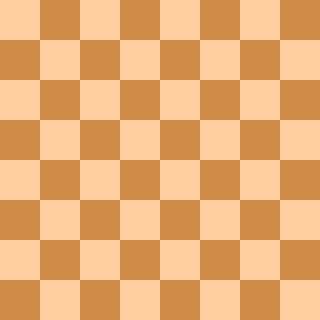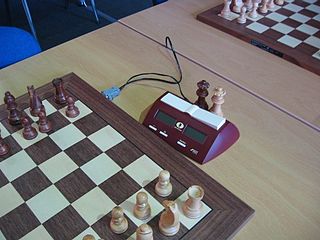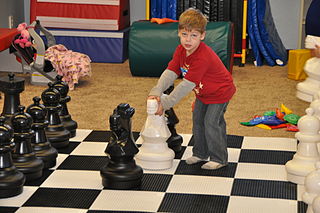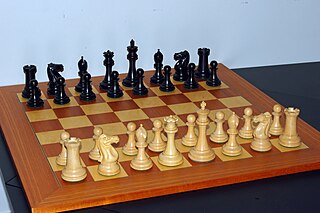 W
WThe rules of chess are rules governing the play of the game of chess. While the exact origins of chess are unclear, modern rules first took form during the Middle Ages. The rules continued to be slightly modified until the early 19th century, when they reached essentially their current form. The rules also varied somewhat from place to place. Today, the standard rules are set by FIDE, the international governing body for chess. Slight modifications are made by some national organizations for their own purposes. There are variations of the rules for fast chess, correspondence chess, online chess, and Chess960.
 W
WCastling is a move in the game of chess involving a player's king and either of the player's original rooks. It is the only move in chess in which a player moves two pieces in the same move, and it is the only move aside from the knight's move where a piece can be said to "jump over" another.
 W
WA check is a condition in chess, shogi, xiangqi, and janggi that occurs when a player's king is under threat of capture on their opponent's next turn. A king so threatened is said to be in check. A player must get out of check, if possible, by interposing a piece between the threatening piece and the king, capturing the threatening piece, or moving the king to a square where it is no longer in check. If the player cannot get out of check by any of these options on their next move, the game ends in checkmate and the player loses. Players cannot make any move that puts their own king in check.
 W
WCheckmate is a game position in chess and other chess-like games in which a player's king is in check and there is no way to avoid the threat. Checkmating the opponent wins the game.
 W
WIn chess, there are a number of ways that a game can end in a draw, neither player winning. Usually, in tournaments a draw is worth a half point to each player, while a win is worth one point to the victor and none to the loser.
 W
WEn passant is a move in chess. It is a special pawn capture that can only occur immediately after a pawn makes a move of two squares from its starting square, and it could have been captured by an enemy pawn had it advanced only one square. The opponent captures the just-moved pawn "as it passes" through the first square. The result is the same as if the pawn had advanced only one square and the enemy pawn had captured it normally.
 W
WPromotion in chess is a rule that requires a pawn that reaches the eighth rank to be replaced by the player's choice of a bishop, knight, rook, or queen of the same color. The piece chosen cannot be another king nor another pawn. The new piece replaces the pawn on its square on the same move. The choice of the new piece is not limited to pieces previously captured, thus promotion can result in a player owning, for example, two or more queens despite starting the game with one.
 W
WStalemate is a situation in the game of chess where the player whose turn it is to move is not in check but has no legal move. The rules of chess provide that when stalemate occurs, the game ends as a draw. During the endgame, stalemate is a resource that can enable the player with the inferior position to draw the game rather than lose. In more complex positions, stalemate is much rarer, usually taking the form of a swindle that succeeds only if the superior side is inattentive. Stalemate is also a common theme in endgame studies and other chess problems.
 W
WA time control is a mechanism in the tournament play of almost all two-player board games so that each round of the match can finish in a timely way and the tournament can proceed. Time controls are typically enforced by means of a game clock, where the times below are given per player. Time pressure is the situation of having very little time on a player's clock to complete their remaining moves.
 W
WThe touch-move rule in chess specifies that, if a player deliberately touches a piece on the board when it is their turn to move, then they must move or capture that piece if it is legal to do so. If it is the player's piece that was touched, it must be moved if they have a legal move. If the opponent's piece was touched, it must be captured if it can be captured with a legal move. If the touched piece cannot be legally moved or captured, there is no penalty. This is a rule of chess that is enforced in all formal, over-the-board competitions. A player claiming a touch-move violation must do so before themselves touching a piece. Online chess does not use the touch rule, letting players 'pick up' a piece and then bring it back to the original square before selecting a different piece, and also allows players to premove pieces while waiting for the opponent to move.
 W
WIn chess, the player who moves first is referred to as "White" and the player who moves second is referred to as "Black". Similarly, the pieces that each conducts are called, respectively, "the white pieces" and "the black pieces". The pieces are often not literally white and black, but some other colors. The 64 squares of the chessboard, which is colored in a checkered pattern, are likewise referred to as "white squares" or "light squares", and "black squares" or "dark squares", though usually the squares are of contrasting light and dark color rather than literally white and black. For example, the squares on plastic boards may be off-white ("buff") and green, while those on wood boards are often light brown and dark brown.white: 1. There are 16 light-coloured pieces and 32 squares called white. Or 2. When capitalised, this also refers to the player of the white pieces.